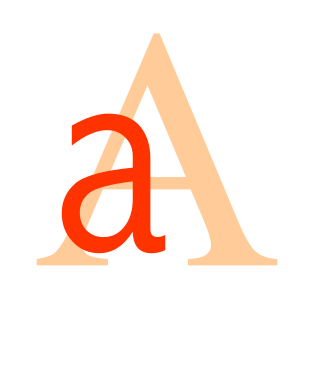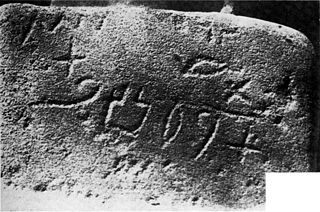
An alphabet is a standard set of letters written to represent particular sounds in a spoken language. Specifically, letters largely correspond to phonemes as the smallest sound segments that can distinguish one word from another in a given language. Not all writing systems represent language in this way: a syllabary assigns symbols to spoken syllables, while logographies assign symbols to words, morphemes, or other semantic units.
In philology, decipherment is the discovery of the meaning of the symbols found in extinct languages and/or alphabets.

Fingerspelling is the representation of the letters of a writing system, and sometimes numeral systems, using only the hands. These manual alphabets have often been used in deaf education and have subsequently been adopted as a distinct part of a number of sign languages. There are about forty manual alphabets around the world. Historically, manual alphabets have had a number of additional applications—including use as ciphers, as mnemonics and in silent religious settings.

Greek is an Indo-European language, constituting an independent Hellenic branch within the Indo-European language family. It is native to Greece, Cyprus, Italy, southern Albania, and other regions of the Balkans, Caucasus, the Black Sea coast, Asia Minor, and the Eastern Mediterranean. It has the longest documented history of any Indo-European language, spanning at least 3,400 years of written records. Its writing system is the Greek alphabet, which has been used for approximately 2,800 years; previously, Greek was recorded in writing systems such as Linear B and the Cypriot syllabary. The alphabet arose from the Phoenician script and was in turn the basis of the Latin, Cyrillic, Coptic, Gothic, and many other writing systems.

The International Phonetic Alphabet (IPA) is an alphabetic system of phonetic notation based primarily on the Latin script. It was devised by the International Phonetic Association in the late 19th century as a standard written representation for the sounds of speech. The IPA is used by lexicographers, foreign language students and teachers, linguists, speech–language pathologists, singers, actors, constructed language creators, and translators.

The Voynich manuscript is an illustrated codex, hand-written in an unknown script referred to as Voynichese. The vellum on which it is written has been carbon-dated to the early 15th century (1404–1438). Stylistic analysis has indicated the manuscript may have been composed in Italy during the Italian Renaissance. While the origins, authorship, and purpose of the manuscript are still debated, hypotheses range from a script for a natural language or constructed language, an unread code, cypher, or other form of cryptography, or perhaps a hoax, reference work, glossolalia or work of fiction currently lacking the translation(s) and context needed to both properly entertain or eliminate any of these possibilities.
In cognitive linguistics, conceptual metaphor, or cognitive metaphor, refers to the understanding of one idea, or conceptual domain, in terms of another. An example of this is the understanding of quantity in terms of directionality or the understanding of time in terms of money.

Analogy is a comparison or correspondence between two things because of a third element that they are considered to share.
The Turkish alphabet is a Latin-script alphabet used for writing the Turkish language, consisting of 29 letters, seven of which have been modified from their Latin originals for the phonetic requirements of the language. This alphabet represents modern Turkish pronunciation with a high degree of accuracy and specificity. Mandated in 1928 as part of Atatürk's Reforms, it is the current official alphabet and the latest in a series of distinct alphabets used in different eras.

Brahmi is a writing system from ancient India that appeared as a fully developed script in the 3rd century BCE. Its descendants, the Brahmic scripts, continue to be used today across South and Southeastern Asia.
Public law is the part of law that governs relations and affairs between legal persons and a government, between different institutions within a state, between different branches of governments, as well as relationships between persons that are of direct concern to society. Public law comprises constitutional law, administrative law, tax law and criminal law, as well as all procedural law. Laws concerning relationships between individuals belong to private law.
A phonemic orthography is an orthography in which the graphemes correspond consistently to the language's phonemes, or more generally to the language's diaphonemes. Natural languages rarely have perfectly phonemic orthographies; a high degree of grapheme–phoneme correspondence can be expected in orthographies based on alphabetic writing systems, but they differ in how complete this correspondence is. English orthography, for example, is alphabetic but highly nonphonemic.

Avar, also known as Avaric, is a Northeast Caucasian language of the Avar–Andic subgroup that is spoken by Avars, primarily in Dagestan. In 2010, there were approximately one million speakers in Dagestan and elsewhere in Russia.

Letter case is the distinction between the letters that are in larger uppercase or capitals and smaller lowercase in the written representation of certain languages. The writing systems that distinguish between the upper- and lowercase have two parallel sets of letters: each in the majuscule set has a counterpart in the minuscule set. Some counterpart letters have the same shape, and differ only in size, but for others the shapes are different. The two case variants are alternative representations of the same letter: they have the same name and pronunciation and are typically treated identically when sorting in alphabetical order.
The Greek alphabet has been used to write the Greek language since the late 9th or early 8th century BC. It was derived from the earlier Phoenician alphabet, and is the earliest known alphabetic script to have developed distinct letters for consonants as well as vowels. In Archaic and early Classical times, the Greek alphabet existed in many local variants, but, by the end of the 4th century BC, the Ionic-based Euclidean alphabet, with 24 letters, ordered from alpha to omega, had become standard throughout the Greek-speaking world and is the version that is still used for Greek writing today.

An acronym is a type of abbreviation consisting of a phrase whose only pronounced elements are the initial letters or initial sounds of words inside that phrase. Acronyms are often spelled with the initial letter of each word in all caps with no punctuation.

The Proto-Sinaitic script is a Middle Bronze Age writing system known from a small corpus of about 30-40 inscriptions and fragments from Serabit el-Khadim in the Sinai Peninsula, as well as two inscriptions from Wadi el-Hol in Middle Egypt. Together with about 20 known Proto-Canaanite inscriptions, it is also known as Early Alphabetic, i.e. the earliest trace of alphabetic writing and the common ancestor of both the Ancient South Arabian script and the Phoenician alphabet, which led to many modern alphabets including the Greek alphabet. According to common theory, Canaanites or Hyksos who spoke a Canaanite language repurposed Egyptian hieroglyphs to construct a different script.

In sociolinguistics, digraphia refers to the use of more than one writing system for the same language. Synchronic digraphia is the coexistence of two or more writing systems for the same language, while diachronic digraphia or sequential digraphia is the replacement of one writing system by another for a particular language.
A writing system comprises a set of symbols, called a script, as well as the rules by which the script represents a particular language. The earliest writing was invented during the late 4th millennium BC. Throughout history, each writing system invented without prior knowledge of writing gradually evolved from a system of proto-writing that included a small number of ideographs, which were not fully capable of encoding spoken language, and lacked the ability to express a broad range of ideas.

The Shan script is a Brahmic abugida, used for writing the Shan language, which was derived from the Burmese script. Due to its recent reforms, the Shan alphabet is more phonetic than other Burmese-derived scripts.












